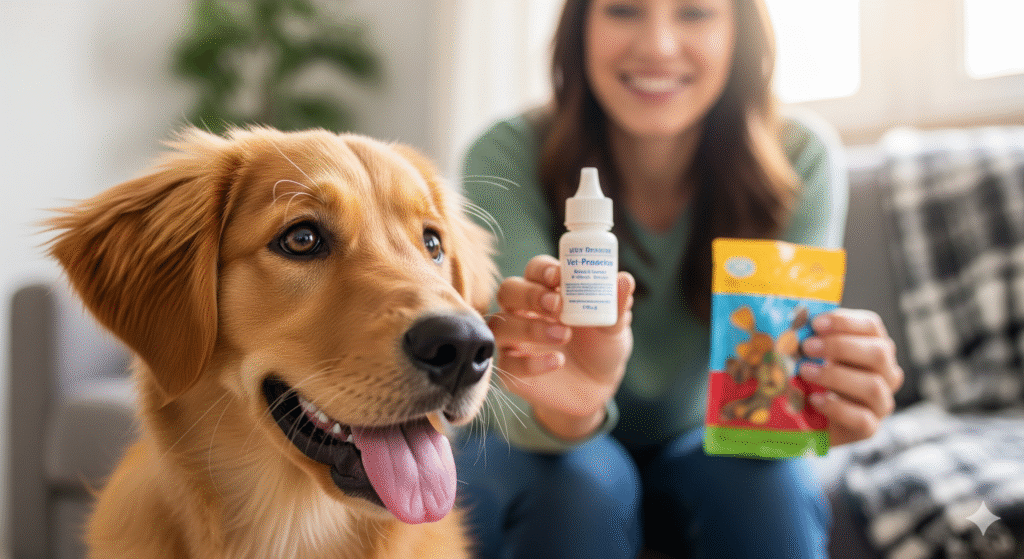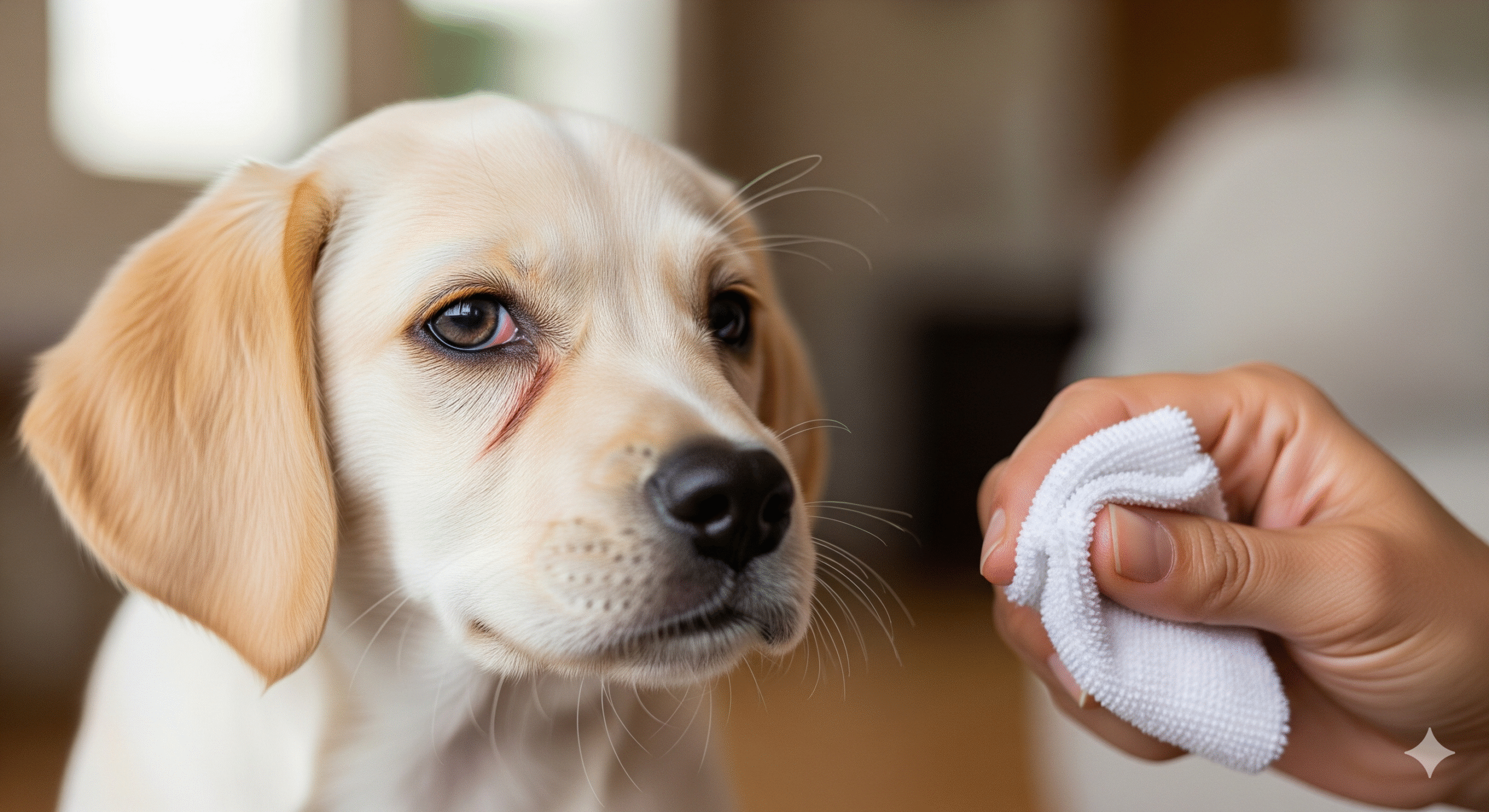Your puppy’s eyes are not just windows to their soul; they are delicate, complex organs that are surprisingly vulnerable to infection and injury. A little bit of “sleep” in the corner of the eye is normal, but when that clear discharge turns green, yellow, or bloody, or the white of the eye becomes angry and red, it’s a clear sign something is wrong. Puppy eye infections are common, but they are never something to ignore. Left untreated, what starts as a simple conjunctivitis can quickly escalate into a vision-threatening problem.
This comprehensive guide will help you become your puppy’s first line of defense. We’ll teach you how to distinguish between a minor irritation and a serious infection, what you can do at home, and—most importantly—when you need to drop everything and call the vet.
Here’s what we’ll cover:
✔️ The 5 most common types of puppy eye infections and their causes
✔️ A detailed list of symptoms so you know exactly what to look for
✔️ Step-by-step first aid for cleaning your puppy’s eyes safely
✔️ Veterinary treatment options and what to expect at the clinic
✔️ How to prevent future infections with simple daily care
✔️ Red flag symptoms that constitute a medical emergency
Let’s clear up the confusion and ensure your puppy’s vision is protected.
Why Puppies Are Prone to Eye Infections 🧐
Puppies are curious explorers, often sticking their faces where they don’t belong. This, combined with their still-developing immune systems, makes them particularly susceptible to eye issues.
- Immature Immune Systems: They haven’t built up full immunity to common bacteria and viruses.
- Breed Predisposition: Breeds with prominent eyes (brachycephalic breeds like Pugs, Shih Tzus) or loose facial skin (Bloodhounds, Cocker Spaniels) are at higher risk.
- Playful Behavior: Roughhousing with littermates can lead to scratches on the cornea (the clear surface of the eye).
- Environmental Irritants: Dust, pollen, and grass seeds can get trapped and cause irritation that leads to infection.
Common Types of Puppy Eye Infections & Their Causes 🔬
1. Conjunctivitis (Pink Eye) 👁️🗨️
This is the most common eye infection, referring to inflammation of the conjunctiva—the moist, pink tissue lining the eyelids and covering the eyeball.
- Causes:
- Bacterial: Often produces a thick, yellow-green discharge.
- Viral: Commonly associated with Canine Distemper virus; often has a watery discharge.
- Allergic: Caused by environmental allergens like pollen or dust; usually itchy with clear discharge.
2. Corneal Ulcer 😖
This is a scratch or abrasion on the cornea. It’s extremely painful and can become infected with bacteria.
- Causes: A scratch from a claw (from a cat or littermate), rubbing against a bush, or getting poked by a foreign object.
3. Blocked Tear Ducts 💧
This isn’t an infection itself, but it can lead to one. Tears aren’t draining properly, creating a moist environment where bacteria thrive.
- Signs: Constant watery overflow onto the face, leading to brownish tear stains.
4. Dry Eye (Keratoconjunctivitis Sicca – KCS) 🏜️
An autoimmune condition where the dog doesn’t produce enough tears. The lack of tears leads to chronic irritation and secondary infections.
- Signs: Thick, mucoid, goopy discharge, red eyes, and frequent blinking.
Signs & Symptoms: Is It an Infection? 🚨
Mild Symptoms (May be managed with vet guidance):
- Clear, watery discharge
- Mild redness in the white of the eye
- Slight squinting or blinking
- Pawing at the eye occasionally
Moderate to Severe Symptoms (Require a Vet Visit):
- Thick, yellow, green, or grey discharge (pus)
- Significant redness and swelling of the conjunctiva
- Constant squinting or keeping the eye completely closed
- Cloudiness or a blueish haze over the cornea
- Visible third eyelid protruding across the eye
- Sensitivity to light
EMERGENCY Symptoms (Go to the Vet Immediately):
- Bloody discharge
- The eye looks obviously physically damaged or out of place
- Your puppy is in extreme pain (crying, hiding, not eating)
- Sudden blindness or bumping into things
What to Do Before the Vet: Safe First Aid 🏥
Do not use any human eye drops or medications. These can be toxic to dogs or mask symptoms your vet needs to see.
- Gently Clean the Area: Use a soft, clean cloth or cotton ball soaked in warm water or a saline solution made for eyes. Wipe from the inner corner of the eye outward. Use a fresh cloth for each eye to avoid cross-contamination.
- Use an Elizabethan Collar (Cone): If your puppy is pawing at the eye, put a cone on them immediately. This prevents them from causing a corneal ulcer or making an existing one much worse.
- Prevent Further Irritation: Keep your puppy in a clean, dust-free area.
Veterinary Diagnosis & Treatment 💊
Your vet will perform tests to determine the exact cause:
- Fluorescein Stain: A special dye is dropped into the eye. It sticks to any damaged areas (ulcers), which will glow green under a blue light. This is the only way to diagnose a corneal ulcer.
- Schirmer Tear Test: A small paper strip is placed under the eyelid to measure tear production. This diagnoses Dry Eye.
- Culture & Sensitivity: If a bacterial infection is severe, they may swab the eye to identify the exact bacteria and the best antibiotic to treat it.
Common Treatments:
- Antibiotic Eye Drops/Ointment: For bacterial infections and to prevent infection in ulcers.
- Antiviral Medication: For viral infections like Distemper.
- Atropine: A pain-relieving drop used for corneal ulcers (it dilates the pupil).
- Artificial Tears: For dry eye or to flush out irritants.
- Oral Antibiotics: For severe infections.
- Surgery: In rare cases for deep ulcers or to correct a blocked tear duct.
How to Administer Eye Medication to a Wiggly Puppy 🎯
- Wash your hands.
- Have treats ready. You want this to be a positive experience.
- Gently hold your puppy’s head steady from behind.
- With your other hand, hold the bottle/dropper above the eye. Avoid touching the eye with the tip.
- Squeeze the prescribed number of drops into the pocket created by the lower eyelid.
- For ointment, apply a thin strip along the inside of the lower lid.
- Let your puppy blink to distribute the medication.
- Reward lavishly with a treat!
Prevention is the Best Medicine 🛡️
- Keep your puppy’s face clean, especially if they are a wrinkly breed.
- Trim the hair around their eyes carefully to prevent it from poking and irritating the cornea.
- Avoid letting them stick their head out the car window; flying debris can cause serious injury.
- Keep vaccinations up to date to protect against viral causes like Distemper.
- Provide a safe play environment free of sharp objects.
Final Checklist: When to Call the Vet
☑️ The discharge is any color other than clear.
☑️ The eye is red, swollen, or your puppy is squinting.
☑️ Your puppy is pawing at the eye excessively.
☑️ The eye looks cloudy or hazy.
☑️ Your puppy seems to be in pain or is lethargic.

Ready to Master Puppy Ear Cleaning? Now that you know what’s involved in a weekly grooming session, it’s time to learn the specifics. Doing this task correctly will prevent infections and make it a positive experience for your pup. For a visual, step-by-step tutorial that builds your confidence, your next read is: Cleaning Puppy Ears: Step-by-Step Guide.






